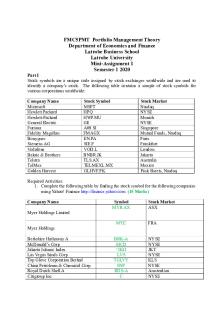STA10003 Assignment 01 PDF

| Title | STA10003 Assignment 01 |
|---|---|
| Course | Foundations of statistics |
| Institution | Swinburne University of Technology |
| Pages | 6 |
| File Size | 265.8 KB |
| File Type | |
| Total Downloads | 89 |
| Total Views | 147 |
Summary
assignment 1...
Description
QUESTION 1: Report: The distribution of Health Status for a random sample of 1500 Californian adults in 2018 is displayed in Figure 1. The most common Health Status response was Good (78.9%) followed by the response Poor (21.1%).
Health Status Cumulative Frequency Valid
Percent
Valid Percent
Percent
Good
1184
78.9
78.9
78.9
Poor
316
21.1
21.1
100.0
Total
1500
100.0
100.0
Figure 1: Distribution of Health Status of Californian adults
QUESTION 2: Report: The distribution of Number of cigarettes smoked the previous day in a random sample of 1500 Californian adults in 2018 is displayed in Figure 2. The distribution is fairly symmetrical with 50% of people smoking 10 or more cigarettes the previous day. Typically, number of cigarettes smoked was between 4 and 18, with half of the number of cigarettes falling within this range. Some respondents reported smoking an exceptionally high amount the previous day of over 23 cigarettes, with the highest being 26 cigarettes. Case Processing Summary Cases Valid N Number of cigarettes
Missing
Percent 235
15.7%
N 1265
Total
Percent 84.3%
N
Percent
1500
100.0%
smoked [previous day]
Descriptives Statistic
Std. Error
Number of cigarettes
Mean
11.25
smoked [previous day]
95% Confidence Interval for Lower Bound
10.24
Mean
12.25
Upper Bound
5% Trimmed Mean
11.07
Median
10.00
Variance
61.426
Std. Deviation
0
Maximum
26
Range
26
Interquartile Range
14
Kurtosis
90
95
23.00 25.00
7.837
Minimum
Skewness
.511
.314
.159
-1.215
.316
Figure 2: Distribution of cigarettes smoked the previous day
QUESTION 3: Report: The distribution of Time walked for leisure in the previous week in a random sample of 1500 Californian adults in 2018 is displayed in Figure 3. The distribution is positively skewed with 50% of people walking leisurely 30 mins the previous week. Typically, the minutes walked the previous week was between 15 minutes and 40 minutes, with half of the minutes walked for leisure falling within this range. Some respondents reported exceptionally high minutes walked in the previous week of over 40 minutes, with the highest being 60 minutes. Case Processing Summary Cases Valid N
Percent
Missing N
Percent
Total N
Percent
Time walked for leisure [mins in previous
985
65.7% 515
34.3% 1500 100.0%
week]
Descriptives Statistic
Std. Error
35.37
Time walked for leisure [mins
Mean
in previous week]
95% Confidence Interval for
Lower Bound
32.87
Mean
Upper Bound
37.87
5% Trimmed Mean
29.91
Median
30.00
Variance Std. Deviation
1596.325 39.954
Minimum
5
Maximum
600
Range
595
Interquartile Range Skewness Kurtosis
1.273
25 6.670
.078
68.313
.156
Weighted Average(Definition 1) Tukey's Hinges
Figure 3: Distribution of time for leisurely walks
QUESTION 4: Dale performed better than the average in both competitions, however his performance was better in Competition B. He scored below the mean in both competitions as the z-scores were negative. The zscore calculations for both competitions can be found below in Figure 4. In competition A, Dale had a standard deviation of -0.625 below the mean, whereas in Competition B, he had a standard deviation of -1.2 below the mean, thus confirming that he performed better in Competition B, when compared to others who took part in that competition.
Calculations:-Competition A Dale’s time (X)= 80 seconds µ= 85 seconds, = 8 seconds z= X- µ
Competition B Dale’s time (X)= 84 seconds µ= 90 seconds, = 5 seconds z= X- µ
= 80-85 8 = -0.625 Figure 4: Values for z- score calculations
= 84-90 5 = -1.2...
Similar Free PDFs

STA10003 Assignment 01
- 6 Pages

Assignment 01 1 - asdfad
- 1 Pages

Assignment 01 Solution
- 3 Pages

Assignment Solutions-Set 01
- 5 Pages

Mini-Assignment 01-FMC5PMT
- 4 Pages

Assignment 01 0 - aloooo
- 2 Pages

ELEC3111-Assignment-01
- 2 Pages

CS Assignment 01
- 2 Pages

AMP1514 Assignment 01 solutions
- 10 Pages

Design Pattern(Assignment 01)
- 5 Pages

Statistic Group Assignment 01
- 32 Pages

STA10003+Week+1+Lecture+Slides 2pp
- 31 Pages

Ijppm-01-2018-0012 - Assignment
- 26 Pages

Assignment FIN420 cash budget 01
- 3 Pages
Popular Institutions
- Tinajero National High School - Annex
- Politeknik Caltex Riau
- Yokohama City University
- SGT University
- University of Al-Qadisiyah
- Divine Word College of Vigan
- Techniek College Rotterdam
- Universidade de Santiago
- Universiti Teknologi MARA Cawangan Johor Kampus Pasir Gudang
- Poltekkes Kemenkes Yogyakarta
- Baguio City National High School
- Colegio san marcos
- preparatoria uno
- Centro de Bachillerato Tecnológico Industrial y de Servicios No. 107
- Dalian Maritime University
- Quang Trung Secondary School
- Colegio Tecnológico en Informática
- Corporación Regional de Educación Superior
- Grupo CEDVA
- Dar Al Uloom University
- Centro de Estudios Preuniversitarios de la Universidad Nacional de Ingeniería
- 上智大学
- Aakash International School, Nuna Majara
- San Felipe Neri Catholic School
- Kang Chiao International School - New Taipei City
- Misamis Occidental National High School
- Institución Educativa Escuela Normal Juan Ladrilleros
- Kolehiyo ng Pantukan
- Batanes State College
- Instituto Continental
- Sekolah Menengah Kejuruan Kesehatan Kaltara (Tarakan)
- Colegio de La Inmaculada Concepcion - Cebu

